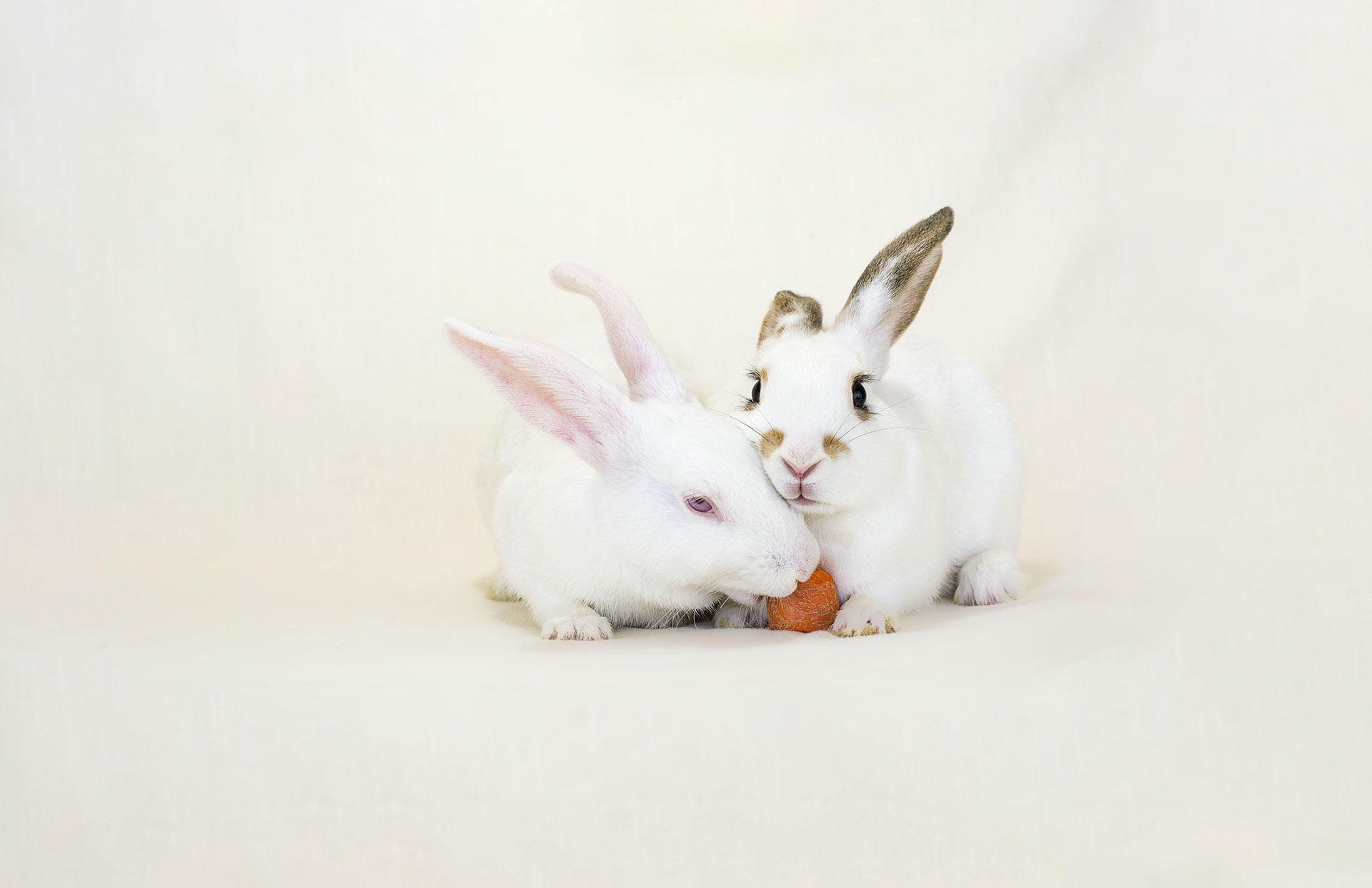When the bonding process gets difficult, some of us start to wonder if it’s a recipe for disaster instead of love. But anyone who has ever had the privilege of seeing a difficult bonding through to success knows it’s worth it. In fact, the most difficult bonding I did at home became the strongest relationship between rabbits I’ve ever seen. Not only were they inseparable, when one of them became sick, the other was able to provide a level of both physical and emotional care beyond my and my vet’s abilities. My rabbits were also closely bonded to me, but I’m certain they lived happier, more fulfilling lives together than they would have had I not found the courage and patience to work through the challenging dating process with them.
There are countless resources for bonding, many of them fantastic. But sometimes the advice sounds more like a recipe for a cake than a courtship: start with this, add some of that, and voilà! Bonding is more an art than a science, and the most important part of the process isn’t a list of basic steps to follow but, instead, your ability to improvise creatively in response to what your rabbits are doing. Variety is the spice of life—and the secret ingredient to a successful bond.
We all know some of the basics for a successful bond: both rabbits MUST be fixed, you MUST house them separately until they’re fully bonded, and you MUST introduce them in neutral space. Also, you’ll probably save yourself some headaches if you let your rabbit pick out their own friend. Below are some thoughts about the process that, while usually not listed among the basic ingredients for a bonding, might just help keep you from going bananas when introducing rabbits isn’t a piece of cake:
You’re in a school zone—slow down! Turns out the Supremes were right: you can’t hurry love. The best way to learn about the bonding process is to slow down and watch your rabbits without worrying too much about rushing them to the next step. Reserve bonding sessions for when you have time to relax and pay attention without multitasking. If you find yourself getting frustrated, it’s OK to take a short break! Your rabbits might need one, too.
It’s ok to make mistakes. People forgive each other; rabbits can, too. If you try something and it doesn’t work, simply stop, and try something else. If a rabbit boxes or tries to bite once, but it doesn’t continue, let it go. The rabbit probably already has. During bonding, you’re looking for trend behaviors, so don’t worry too much about something you see only once or twice, particularly if the rabbits seem to recover quickly. Also, it’s OK to try new things as long as you’re putting your rabbits’ safety first. After all, someone likely discovered the magic of car rides by simply trying one. You might just discover a new technique you can share with others!
One way, or another. Some people recommend nudging rabbits close to one another during the bonding process or gradually reducing the amount of space between them. Other people recommend letting rabbits space themselves and letting them approach one another on their own terms. Who’s right? Everyone. Some rabbits might benefit from a little nudge and others really need to feel safer before they venture closer. How do you find out? Watch them and try both to see what they respond better to. Some rabbits might prefer space in the beginning and will allow a little nudging as they get more comfortable. You will only know if you try both, watch what happens, and respond accordingly.
There are no haters. No, rabbits aren’t mean, nor are they aggressive. They’re scared. We know this instinctively, and yet when rabbits start to fight, we’re always so sure which one of them bit first (“That jerk bit my Floofy!”). Next time you see a rabbit turn into Jaws during a date, try to remember how scary dating is, and offer extra comfort and support instead of blame. Also, slow down and see if you can figure out what prompted Jaws. I once salvaged a bad date by removing a toy both rabbits seemed to feel was theirs. The date continued uneventfully.
You don’t actually have any truly neutral space in your home. You’re usually not able to completely eliminate the scents in your home; just mitigate them. Keep in mind the behaviors you’re seeing might be territorial even if you’re in a room the rabbits haven’t been in before. It’s OK; just do your best with the space you have. If you think you’re seeing behaviors that are territorial at home, ask a friend if you can bring your rabbits and an exercise pen over for an afternoon and try the bonding there.
Stop projecting. Resist the urge to develop a script around your rabbit’s behavior that sounds like it would fit Jennifer Aniston in her next rom-com. Rabbits are complicated, but they’re not little fuzzy humans. Did your rabbit bite the other rabbit’s butt because they’re jealous? Look, I really don’t know what your rabbit is thinking—and neither do you. Your job is to keep the rabbits safe and let them work things out themselves. Keep an open mind and let the rabbits communicate to you the only way they can: through their actions.

Nothing is happening. Au contraire: *something* is happening! And if you’re not paying attention, you’ll miss it! Even when they’re turned away from one another, rabbits are well aware of the presence of another rabbit in their pen, and they are subtly communicating. Did one of the rabbits just lick their face, only to do it again a few minutes later? It didn’t suddenly get dirty. Your rabbit is signaling to the other rabbit. And more often than not, you’ll eventually see the other rabbit start signaling back, with the same behavior. Then one flops over. And then the other one flops. Even when they’re not interacting, they may still be “talking.” All these little signals are part of the process.
When fighting isn’t fighting. Sometimes they’re just running around the exercise pen because they’re scared (you can calm them with some nose rubs). If they’re circling and biting, break it up! But resist the urge to break them up before they ever get near one another because you’re afraid they might bite. Or, maybe one rabbit bit the other rabbit’s booty. Did the rabbit who got bit react? If not, let them be. It’s probably flirty. Bonding can be scary but they’ll never become a couple if you keep jumping between them. I promise you’ll find the balance between intervening too soon and too late once you get going.
Rabbits are bonded when they figure out who is dominant. Rabbit relationships may be less complicated than human ones, but they’re probably more complicated than you think. They likely share dominance to some degree, and it may be situational. What they’re learning during the bonding process is to trust, not who will be boss.
They kissed—I’m done, right? Not so fast … bonding isn’t linear. It’s two hops forward and one thump back. Every relationship has bumps! If you have a series of good dates followed by a bad one, it doesn’t mean it’s over. Sometimes we’re lucky in our human relationships and that special someone gives us a second chance when we’ve made a mistake. Give your bunnies room to make their own mistakes. Let your rabbits decide if they are willing to give this a second chance—they probably are.
Food for Thought
Every rabbit is different, and every relationship is different. And oftentimes rabbits are helping the process by doing things that probably go unnoticed or misunderstood by humans. It’s why advice that’s given as a recipe doesn’t always work by itself. Instead of getting frustrated, get creative! It’s OK to experiment with bonding techniques as long as you’re keeping your rabbits safe in the process. Most importantly, you’ll develop a closer relationship and understanding of your furry companions, and you’ll be more likely to live the happily-ever-after that you had in mind when you started. And that’s a recipe you can hand down to future generations.
Editor’s Note: Due to the emergence of Rabbit Hemorrhagic Disease Virus Type-2 (RHDV2), House Rabbit Society recommends rabbits be vaccinated before introducing them to new potential friends, in states the vaccine is available.
Reviewed by HRS staff
Author: Sandy ParshallPhoto Credit: Sandy Parshall
Journal Issue: House Rabbit Journal, Winter 2021





